Sascha Pohle has been working in various media for several years. With photos, film, objects, textiles, artist books, and often using art and film references, he appropriates representations of our material and visual culture. In staged collections, his art often plays with historical and anthropological evocations. There, labor-intensive handmade or machine-made objects become presented as fluid and performative processes negotiating the migration of forms, patterns, or people. Macro and micro perspectives of surface structures and places serve the constant preoccupation with individual and collective memory and belonging.
Sascha Pohle lives and works in Seoul and Düsseldorf. His recent works were on display with solo shows including ‚Passage’, Gregorzki Shows, Berlin, ‘Given Time, Black Sesame’, Institute for Provocation, Beijing, CN (2016); 2015 Home Sequence, Rongwrong, Amsterdam, NL; with group exhibitions such as WALK!, Schirn Kunsthalle Frankfurt, DE (2022), Festival Visiona Huesca, ES (2022), Macao Biennale ‚Advance and Retreat of Globalization‘, (2021) ‚Glancing Into The Sun, Hongcheon Museum, KR (2018); The 3rd Today’s Documents BRIC-á-brac The Jumble of Growth, Today Art Museum, Beijing, CN (2016), Plastic Myths, ACC Asia Culture Center, Gwangju, KR (2015/16), Globale: Global Control and Censorship, ZKM, Karlsruhe, DE (2015)
Juergen Staack works in the border areas of photography, images and image creation. In the process, fundamental questions open up, which are examined and dealt with. "What is a picture?", "What makes a picture?", "How, where and when does a picture come into being?", "What significance does a picture have in a world that is characterized by visual stimuli?", "Does a picture have to have a picture carrier in order to be IMAGE?"
In various approaches, he has lost image originals, reinterpreted them, let them decay, transcribed them, destroyed them, and transferred them to other media. In many works, communication and pseudo-communication play an important role.
Languages "threatened with extinction" serve as image descriptions, simultaneous interpreters create translations of museum visitors, photos on sand destroy themselves, the "ice whisper" transfers a narrative into a clink at -57°C, and Chinese policemen abstractly paint over through censorship and create paintings, a shadow of a flower falls into a notebook.
Juergen Staack lives and works in Düsseldorf, Germany. His recent works were exhibited in solo shows including 'Ruff, Feldmann, Staack' at Konrad Fischer Gallery, 'Reduction of Reality' at Oldenburger Kunstverein, 'Zwei' and 'Transformation' at Konrad Fischer Gallery Berlin/ Düsseldorf and 'Left behind, missing pictures' at Space Other Gallery Boston, with group exhibitions such as 'A project for an Aging World' SOCIO-1 Osaka (2022), Weltkunstzimmer Düsseldorf (2022), Kunstmuseum Bonn (2021), Arthena Foundation KAI10 (2021), Kunsthaus NRW (2019), Bundeskunsthalle Bonn (2018), 21er Haus Belvedere Vienna (2017), Museum Morsbroich (2017), Kunsthalle Mainz (2017), National Museum Tirana (2016), MMCA Seoul (2013), Museum Osthaus Hagen (2013), Riga Art Space (2012), Galerie Helga de Alvear Madrid (2012), Museum Fokwang Essen (2011), Konrad Fischer Gallery Berlin (2009)
invited by Sascha Pohle
Tao G. Vrhovec Sambolec (SI/NL) is an artist and researcher with a particular focus on sound, new media, real-time interaction, and questions of contemporary mediation in relation to the sense of (bodily) presence. His recent work consists of spatial and sound installations, events, and interventions, where (un)mediated sonic events act as central elements that affectively evoke human bodily presence while signaling its physical absence. Conceptual in their approach while addressing the visitors through sound, tactility, kinetic movement, and vibration, such artistic works intend to question in what way human bodily presence can be felt and sensed beyond the directness of visuality and vicinity, and further, what kind of new poetics these re-articulations can form.
His works have been presented internationally at museums, galleries, project spaces and contemporary art biennales and festivals, amongst others in Kapelica Gallery - Ljubljana, Errant Sound – Berlin, The Listening Biennial, Aksioma Project Space – Ljubljana, Sonic Acts Festival - Amsterdam, Sound Disobedience Festival - Ljubljana, Ars Electronica Festival, V2_Lab for the Unstable Media - Rotterdam, Museum of Contemporary Art Metelkova, +MSUM - Ljubljana, AV Festival - Newcastle Upon Tyne, Gwangju Museum of Art - South Korea, Reseach Pavilion - Venice, Madrid Abierto, Forum Neuer Musik - Köln, CMMAS - Morelia, Mexico, MuseumsQuartier – Vienna, Sound Gallery – Bergen.
invited by Sascha Pohle
Tim Löhde, developed his artistic practice inbetween the areas of sound and image-based works. He explores musical structures and the interaction of sound, language, image, and object in terms of how sound functions as a polyphonic transmitter for information, emotion, and imagination. In various installations, he reproduces moments that moved him in depth and researches the strategies of conveying them into an audible experience. These moments can arise from found objects, music, global and historic events, mythologies, and stories from individual people. He is interested in the possibilities and processes of reproducing these moments and how cultural archiving and reproduction techniques change through time and are perceived differently. In doing so, he consciously makes use of the technique of polyphony, allowing several contexts and sound sources to interact and run them simultaneously. For him, this is an important reflection of today's globalized environment, which is marked by perpetual simultaneity. His works result in different exhibition contexts, in collaborations, site-specifically, and in the outside space. Moreover, he creates electronic music and gives experimental concerts using synthesizers and sound recordings.
Tim Löhde lives and works in Düsseldorf, Germany. Most recently his works have been exhibited at Da in die Front, Düsseldorf, Germany (2022), Assembly House, Leeds, UK (2022), Jung-gu Street of Culture Contemporary Art Festival, Ulsan, South Korea (2022), Plongee Art Space - Düsseldorf (2021), Elephant Space, Seoul, South-Korea (2020/2021), Tentacles Gallery, Bangkok, Thailand (2019), Chiba Prefectural Museum of Art, Chiba, Japan (2019), Kunstraum Düsseldorf, Germany (2018), Kunsthalle Düsseldorf, Germany (2016/2017), Marres House For Contemporary Culture, Maastricht, Netherlands (2017) and at the Ruhrtriennale 2015 - with Jens Kothe, Bochum (2015). In 2018 he was an artist in residence at the Seoul Museum of Art, South Korea. In 2019 he gave a concert at Kunstsammlung NRW - K21 together with Chris Dreier (Tödliche Doris) and released an album at SB34, Brussels with O.J.A.I. (2021). In 2020 and 2021 he received funding from the Kunststiftung NRW and the Stiftung Kunstfonds.
invited by Sascha Pohle
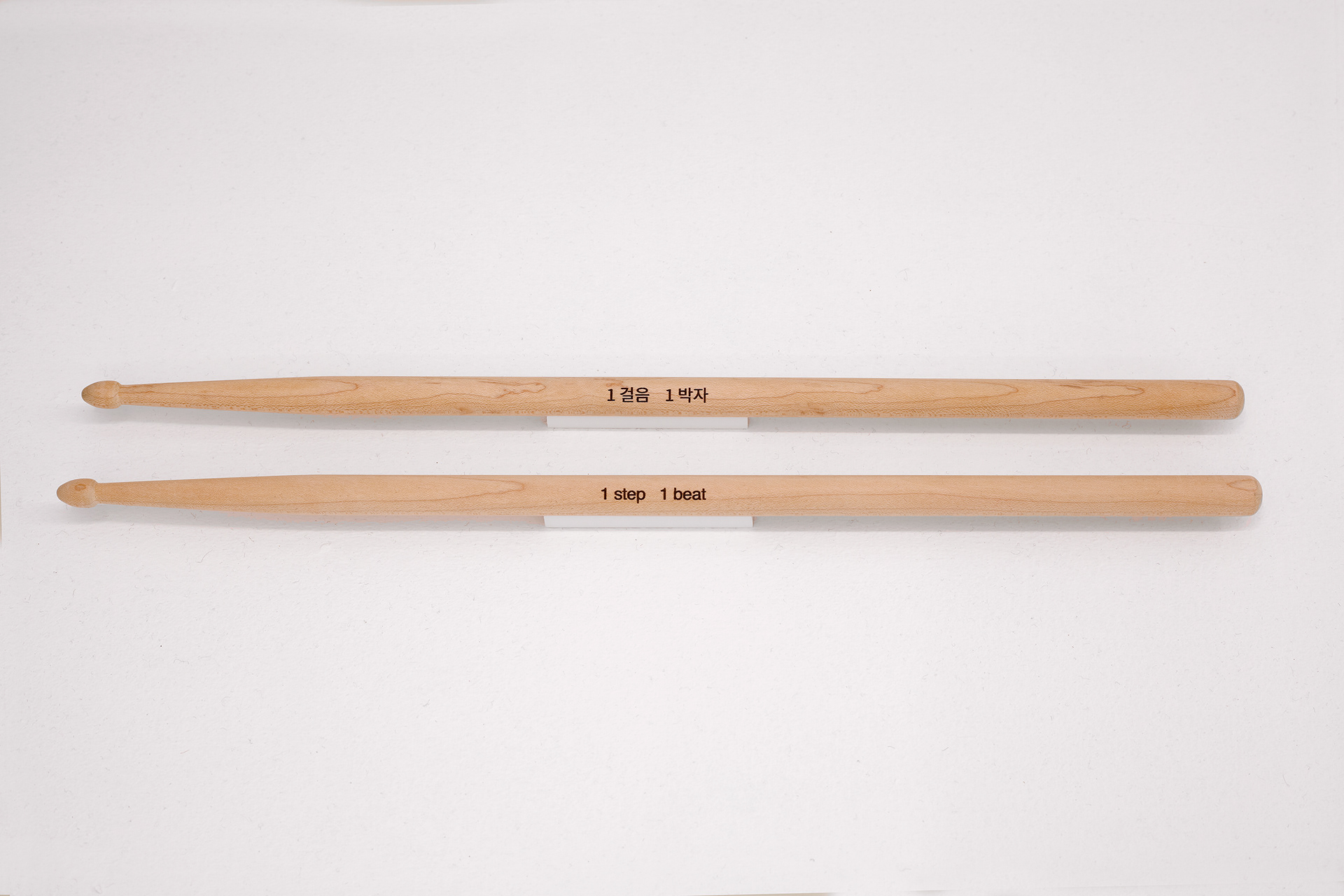

Tao G. Vrhovec Sambolec
1 step 1 beat - 1걸음 1박자 (2022)
(a journey of an idea from one place to another), two drumsticks with laser cut inscriptions.
1 step 1 beat - 1걸음 1박자 is a performative object - a score, an instrument and an artifact. The work is a continuation of the series 1 step 1 beat (2019- ), that was initiated in Tirana - Albania as a commission by The National Gallery of Arts, Tirana for Exchanges and Misunderstandings Performance Program in the context of the exhibition Best Wishes for 1999: The Jan Dibbets Collection, curated by Arnisa Zeqo.
There, a series of 30 drumsticks with inscription 1 step 1 beat and 1 hap 1 rrahje (Albanian translation) were given to the exhibition visitors as an invitation to contemplate or to actively interpret and use the drumsticks. The work was conceived as a response to stanley brouwn’s work 1m 1 step, that is a part of Jan Dibbets Collection at The National Gallery of Arts in Tirana. Relating to stanley brouwn’s exhibited work, and presented together with the performance Heredrum, the performative object pointed towards a relation between a step and a meter in the temporal domain, while the bilingual inscription evoked the journey of an idea from one place to another.
The present iteration of the project is an edition of one pair of drumsticks with inscriptions 1 step 1 beat - 1걸음 1박자. The work was produced in Amsterdam – The Netherlands and sent to Seoul for the exhibition Workplace Sequence, continuing a journey of an idea from one place to another.
With thanks to Sylbee Kim
1 step 1 beat - 1 걸음 1 박자는 행위를 위한 오브제이다. - 악보, 악기, 인공물. 해당 작업은 1 step 1 beat (2019~) 시리즈의 연작이다. 1 step 1 beat 시리즈는 티라나에서 착수되었다.- 작가는 알바니아 국립 미술관, Tirana for Exchanges and Misunderstandings Performance Program에서 작업 의뢰를 받았다. 퍼포먼스 프로그램은 Arniza Zeqo가 기획한 Best Wishes for 1999: The Jan Dibbets Collection 전시와 연관되어 있다.
1 step 1 beat - 1 hap 1 rrahje(알바니아어)가 새겨진 드림 스틱 30개 시리즈는 전시 관람객들에게 깊이 생각하거나, 적극적으로 해석하거나, 드림 스틱을 사용할 초대권으로 제공됐다. 이 작업은 티라나 국립 미술관의 Jan Dibbets Collection의 일부인 Stanley brouwn의 작업 1m 1 step에 대한 회신으로 구상되었다.Stanley Brouwn의 전시된 작품은 Heredrum 퍼포먼스와 함께 선보였다. 함께 선보인 퍼포먼스 오브제는 두 언어로 새겨진 글이 한 장소에서 다른 장소로 아이디어의 여행을 환기하는 동안 시간의 영역에서 걸음과 미터 사이의 관계를 가리켰다.
1 step 1 beat - 1 걸음 1박자 라고 새겨진 한 쌍의 드럼 스틱 에디션은 반복 프로젝트이다. 이 작품은 암스테르담에서 제작되었다. - Workplace Sequence 전시를 위해 네덜란드에서 서울로 보내졌고 한 곳에서 다른 곳으로 아이디어의 여행을 지속하는 중이다.
김실비님께 감사를 표한다.

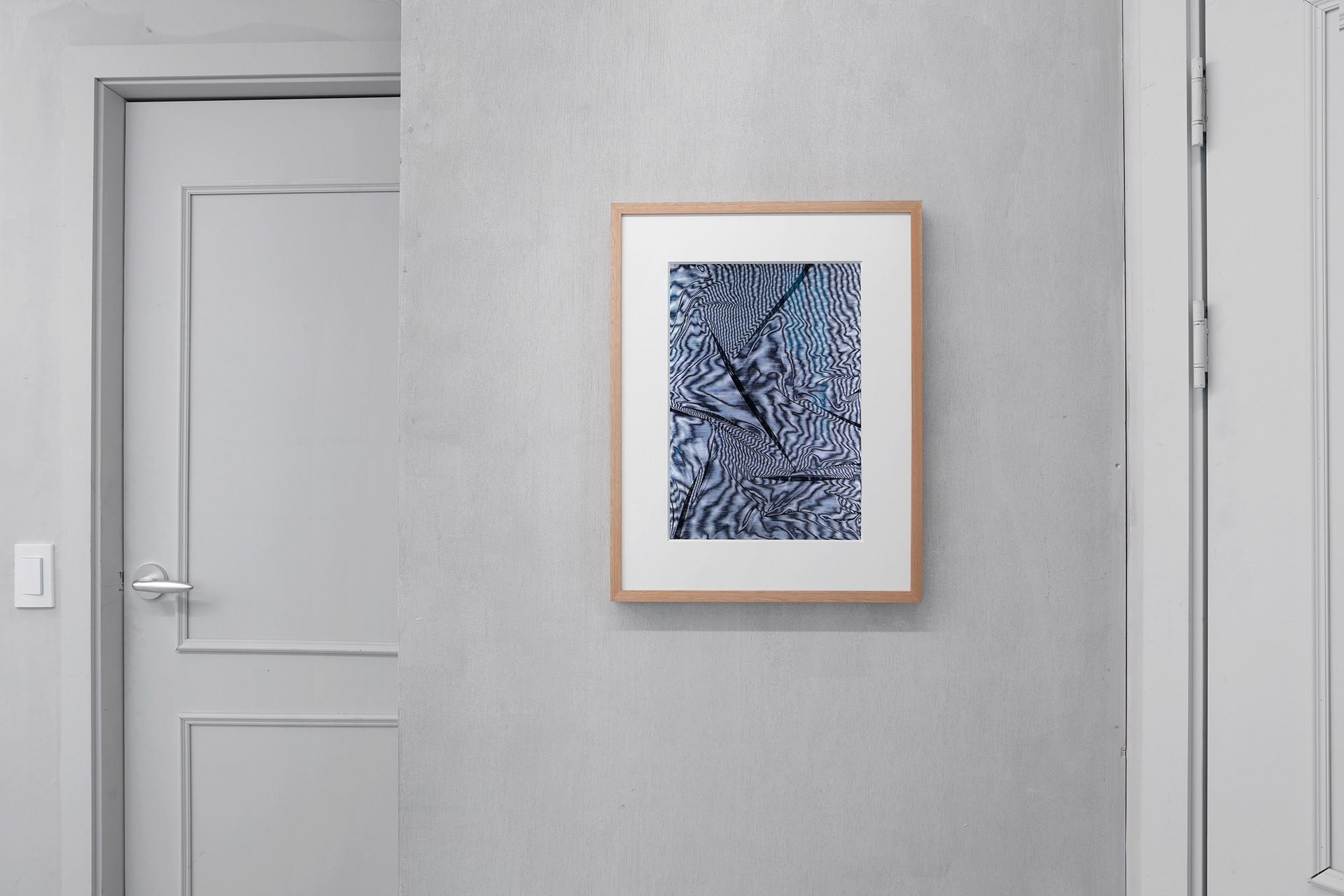
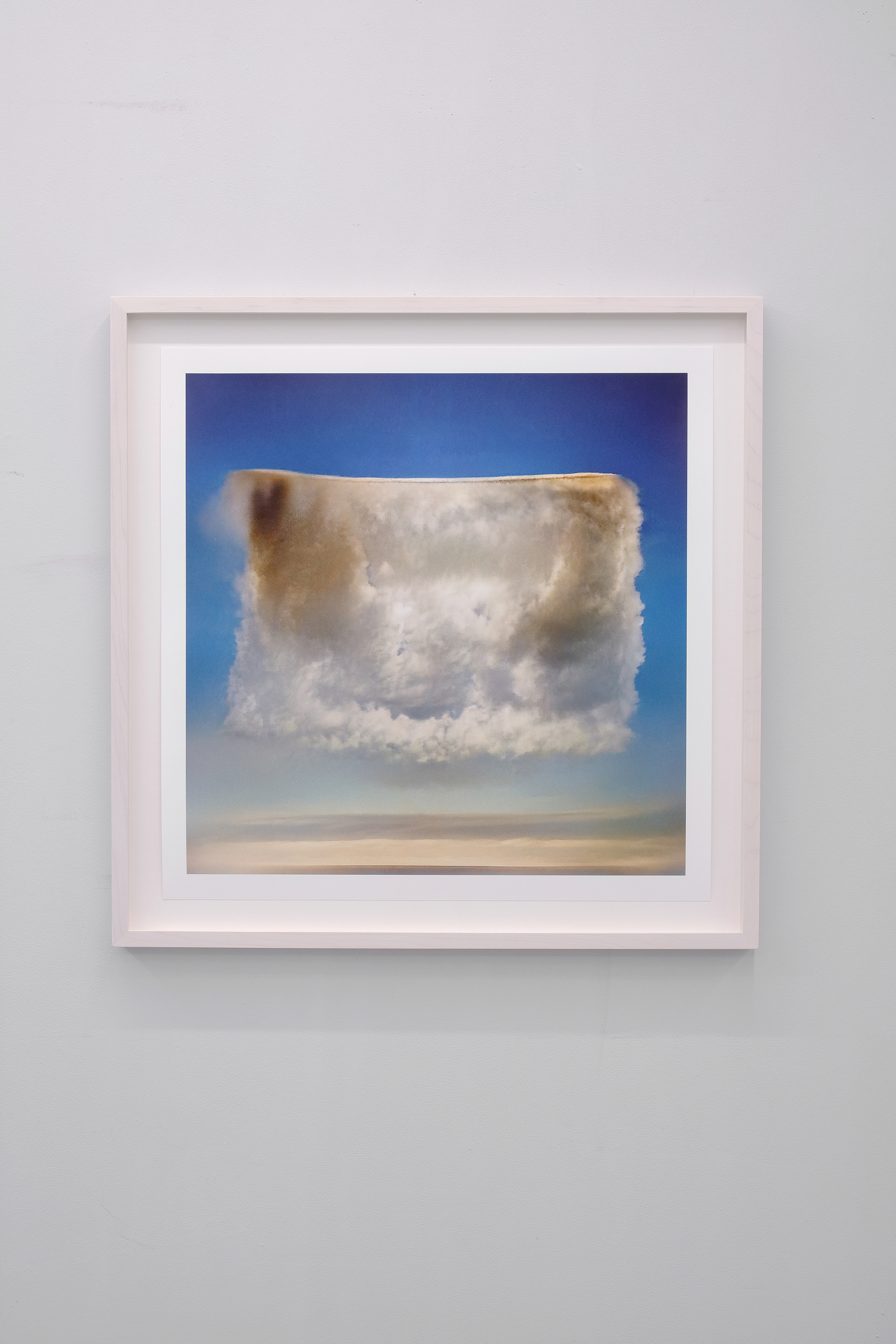

Juergen Staack
Aberration/ M2 series (2019 - ongoing)
M20220120 (black), 2022. 40x50 cm, unique piece
The series Aberration /M2 deals with the aberration and visual disturbance of the moiré. A moiré often occur in digital photographs when two identical halftones meet. It can be seen as uncontrolled patterns in digital images and in prints, and becomes unavoidable without losing sharpness, unless improving resolution of the camera technology. As a method Staack makes use of the unintentional aesthetic of the technological error, and addresses the border areas of photography and images.
In the Aberration/ M2 series Staack eliminates any motif in order to become an abstract moiré image. When moving closer to the work the viewer might perceive changes such as image depths that sometimes resemble a hologram. As a master student of Thomas Ruff, he works in a tradition of expanding and questioning the areas of artistic photography.
Aberration/M2 시리즈는 디지털 카메라 또는 기타 감광 장치에서 발생했던 무아레(모아레, moiré) 즉 광학 수차와 시각적 간섭 현상에 대한 작업이다. 디지털 사진에서는 동일한 망점이 겹칠 때 무아레 무늬가 나타날 수 있다. 무아레는 디지털 영상과 인쇄물에서 제어되지 않는 패턴으로 볼 수 있으며, 카메라 기술의 해상도를 향상시키지 않는 한 선명도를 잃지 않고 피할 수 없게 된다. 작가는 기술 오류로 인해 유발되는 ‘의도치 않은’의 미학을 활용하는 방법으로 사진과 이미지의 경계 영역을 다룬다.
Aberration/M2 시리즈에서는 Staack가 추상적인 무아레 이미지를 만들기 위해 모든 모티브를 제거한다. 작품을 가깝게 이동시킬때 관람자는 예를 들어 홀로그램과 비슷한 이미지의 깊이감과 같은 변화를 감지할 수 있다. Staack는 Thomas Ruff의 석사 학생으로서, 그는 전통적인 사진의 확장과 예술 사진에 대해서 질문을 던지는 작업을 한다.
V1S10N
#ASC-1
2022
In the current series V1S10N, Staack uses an A.I. to create photographic images that claim to faithfully reproduce reality, but become surreal photographic representations through absurd algorithms.
신작 V1S10N 시리즈에서 작가는 A.I. 를 활용하여 현실을 충분히 재현할 수 있다고 주장하기 위한 사진 이미지를 생산했지만 결과적으로 무작위적인 알고리즘에 의해 초현실적인 사진 표현이 되었다.
Tim Löhde
Pair Balanced Crash – Radevormwald, 2021
Sound-Piece, 60min
A 60-minute sound recording that consists of 24 hours of superimposed recording tracks from the artist's room. Without following a special dramaturgy, the interwoven atmosphere of the room is stored acoustically in order to transport it to another place. You can hear phone calls, work noises, silent piano practices, music, visitors, dropping things, street noise and silence.
작품은 작가의 방에서 24시간 동안 녹음된 트랙들을 덧붙여 60분으로 구성되었다. 특별한 연출 없이 방 안 분위기는 다른 장소로 전달될 수 있도록 청각적으로 저장된다. 작품에서 전화가 울리는 소리, 작업하는 소리, 음량 조절이 가능한 피아노 연습, 음악, 방문자들, 물건을 떨어뜨리는 소리, 거리의 소음과 고요를 들을 수 있다.
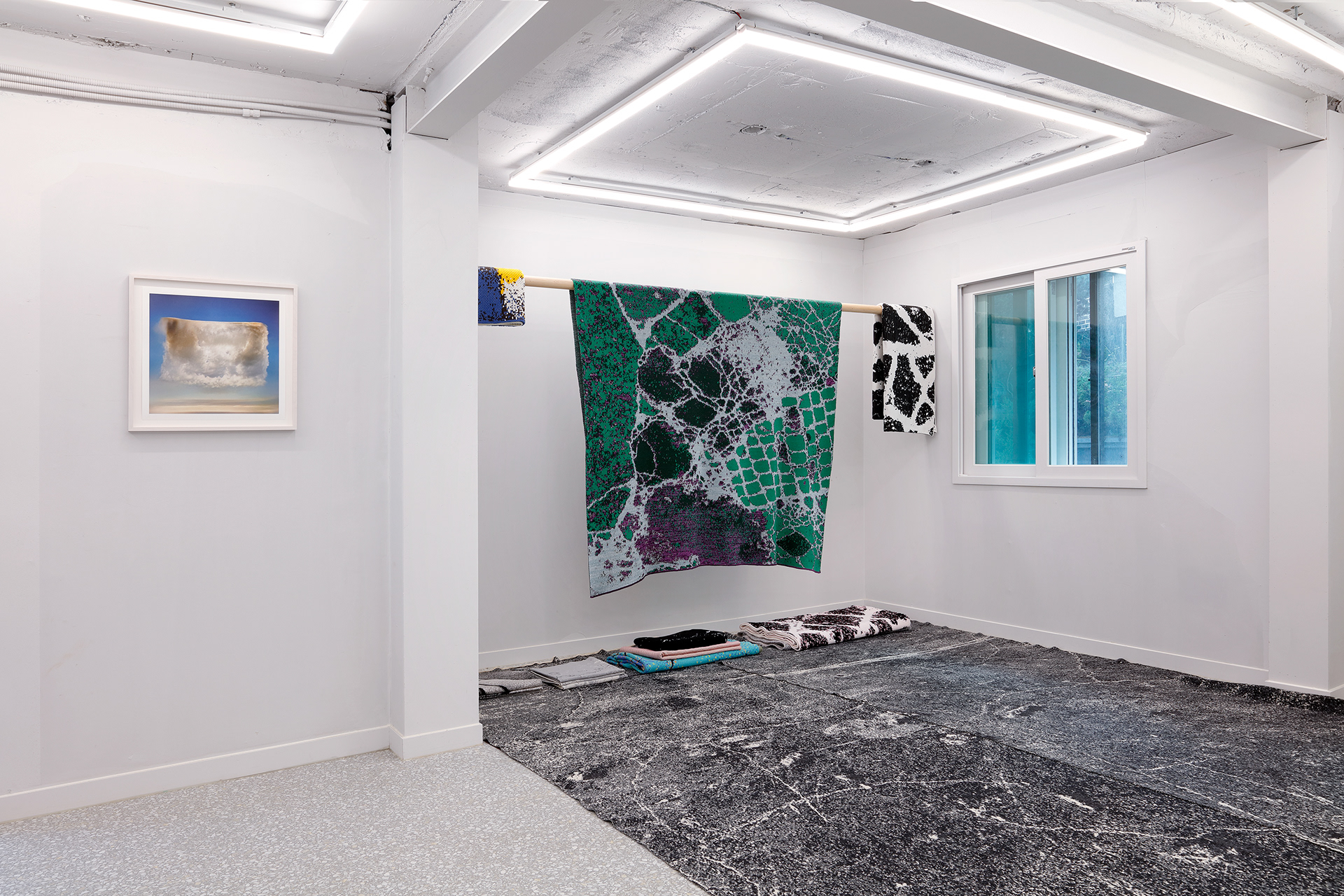

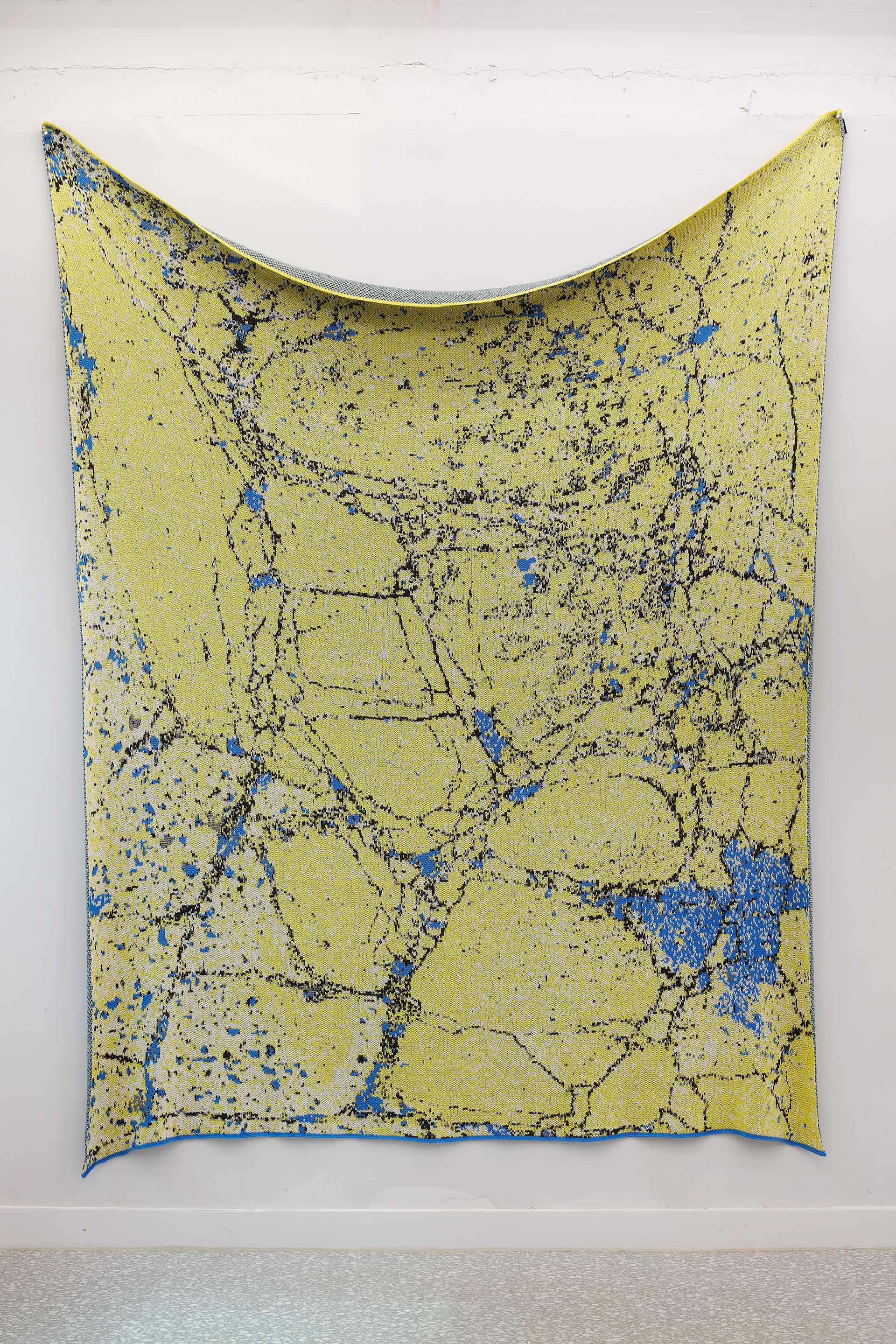
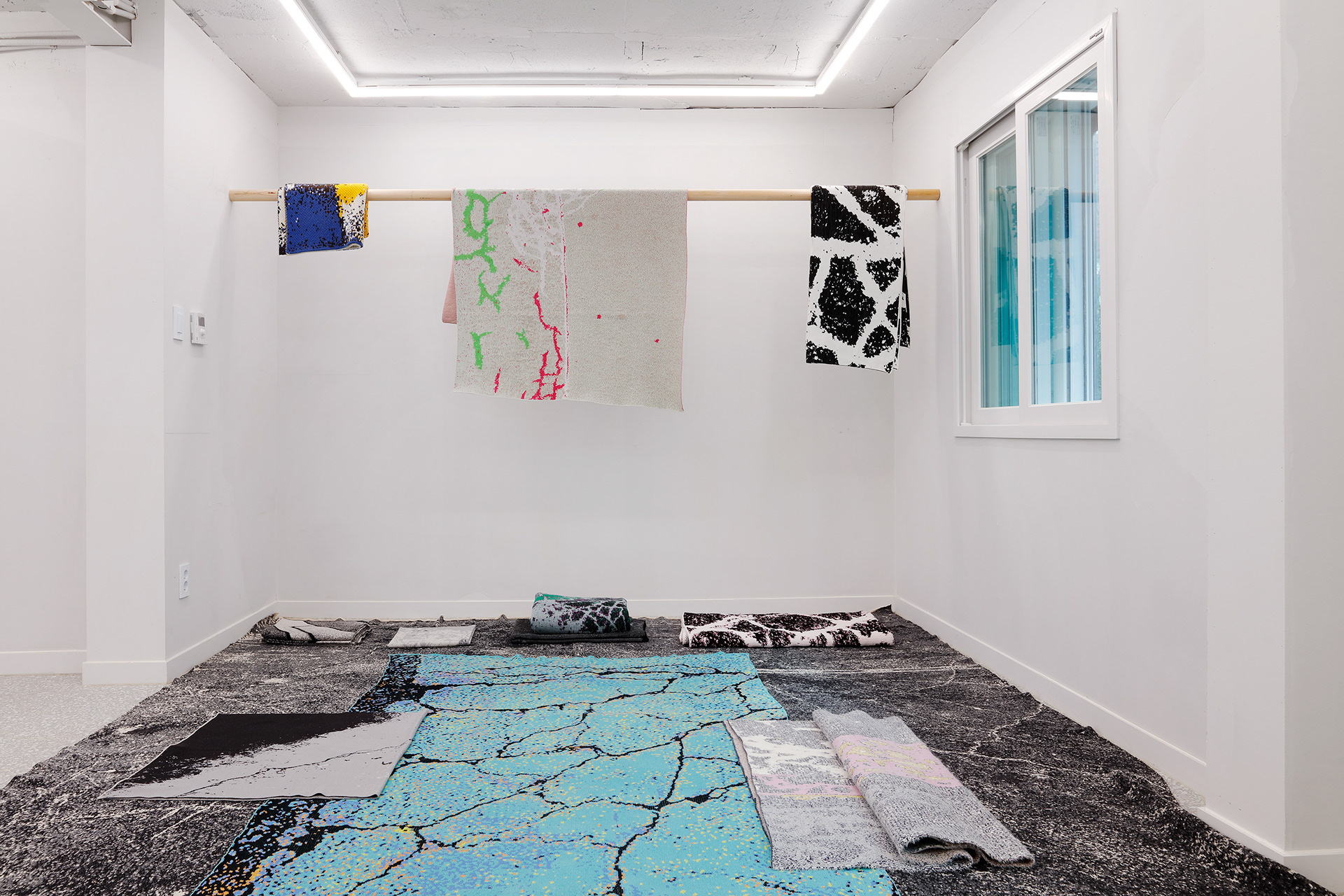
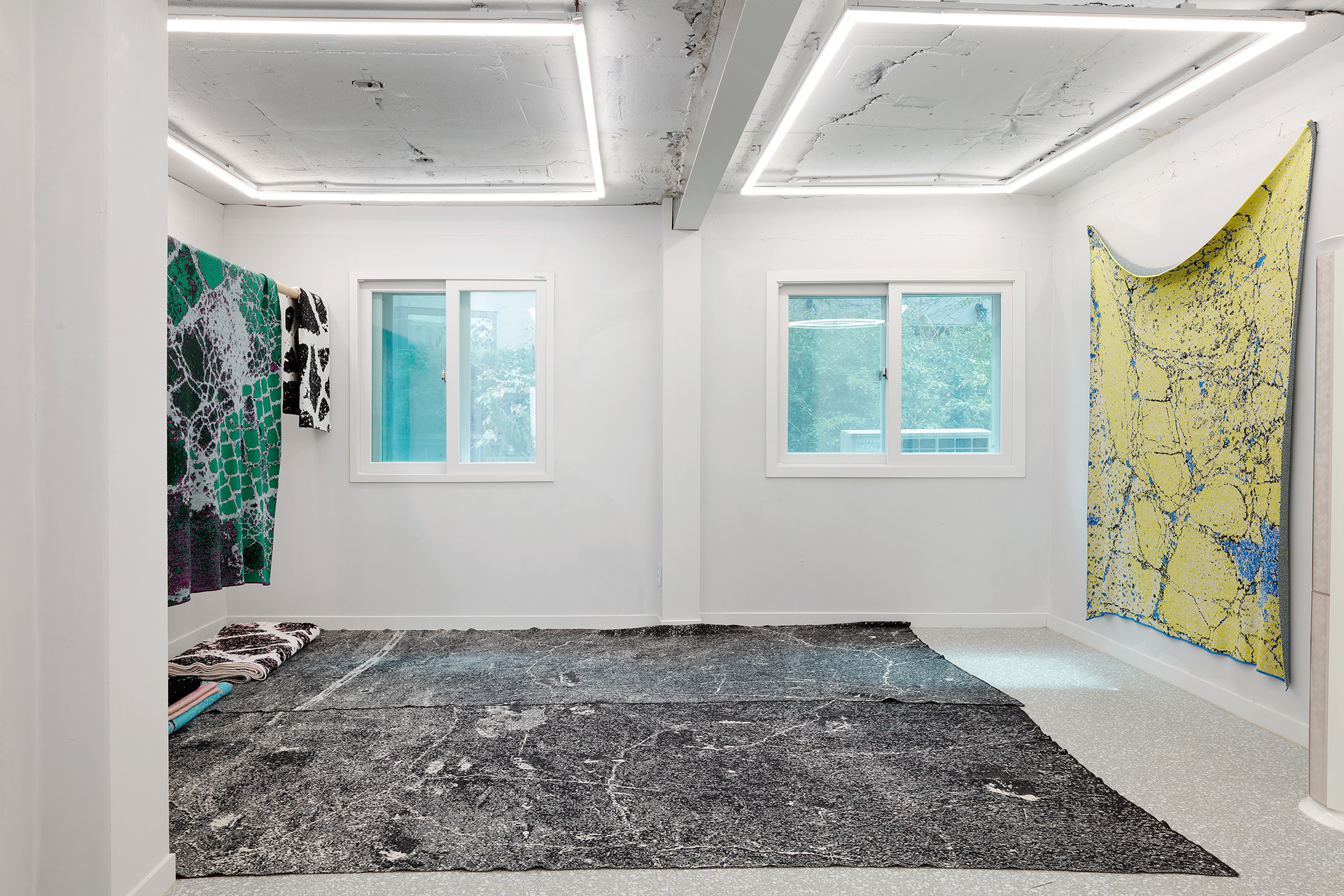

Sascha Pohle
Passage, 2017 (ongoing)
machine knitted fabrics, mixed material
Passage is an ongoing work that consists of various machine knitted fabrics transferred from digital photographs, snapshots made with a mobile phone camera, of urban asphalt from various cities where Sascha Pohle does or has lived and worked. In Passage solid terrain, the hard and damaged public ground becomes converted into intimate soft structures. Knits are repeatedly folded and carefully arranged on tables, shelves, or, as in this new exhibition, on a large-scale two-piece knit with a motif originating from the floor of his former workplace. The image is inspired by Man Ray’s photograph Dust Breeding (1920) showing Marcel Duchamp’s The Large Glass in his studio in a manner reminiscent of an aerial view.
In the form of a tangible ‘walk’ or ‘sit’, the knits are presented by one or more performing ‚flaneurs’ unfolding endless arrays of combinations, overlaps, colors, shapes, and patterns. The only information the audience receives is the name of the city and the percentage of used fibers. Passage is a fluid index - and a versatile object that oscillates between cloth for fashion, archival documents, or folding maps. Drifting is practiced as a visual and haptic exercise of micro-perspectives of an artist’s life in contemporary realities and territories.
Performers: Yedam Koo, Sze Wing Lai
Passage는 작가가 거주하거나 일했던 여러 도시의 아스팔트를 디지털 사진과 스냅샷으로 촬영하고 이미지를 직물로 전환한 작업이다. Passage에서 단단하고 손상된 지면은 친근하고 부드러운 구조로 바뀐다. 니트는 반복적으로 접혀 테이블과 선반에 조심스럽게 정리된다. 이번 전시에서는 그의 예전 작업실 바닥을 참고하여 제작된 큰 규모의 두 니트 위에서 이뤄진다. 이미지는 마르셸 뒤샹 Marcel Duchamp의 The Large Glass가 보이는 작업실에서 조감도가 연상되는 방식의 만 레이Man Ray의 Dust Breeding (1920)에서 영감을 받았다.
실질적으로 ‘걷거나’, ‘앉는’ 방식에서 한 명 이상의 연기자는 니트를 조합하거나, 서로 겹쳐고 펼치면서 끊임없이 색상, 모양과 패턴을 새롭게 배열하는 방식으로 선보인다. 관람객이 받는 유일한 정보는 도시의 이름과 직물의 혼방 비율이다. Passage는 유동적인 목록이자 패션을 위한 옷감, 보존문서, 또는 접는 지도 사이를 오가는 가변적인 오브제이다. 이와 같은 의미의 표류는 현대적 현실과 영역에 속해있는 한 작가의 삶을 마이크로 관점에서 바라보는 연습이 시각과 촉각으로 느낄 수 있는 운동으로 표현되어 실행되었다.
퍼포머: 구예담, 여시영